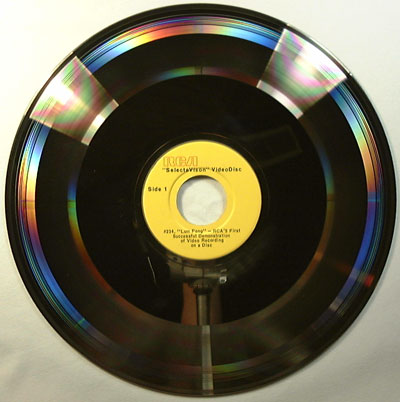
 |
Search | FAQ | US Titles | UK Titles | Memories | VaporWare | Digest | |||||||
| GuestBook | Classified | Chat | Products | Featured | Technical | Museum | ||||||||
| Downloads | Production | Fanfares | Music | Misc | Related | Contact | ||||||||
| CED in the History of Media Technology | ||||||||||||||

RCA experimental VideoDisc #234 was manufactured in September 1972, and was considered by RCA's CED staff to be the first successful demonstration of color video recording on a disc. The disc contained ten minutes of a Get Smart TV show, and was demonstrated with great excitement to the entire RCA Laboratories' community at their monthly colloquium session. This disc contained 4000 grooves/inch, which was a doubling of the 2000 grooves/inch that had been the maximum possible a few months earlier. This metallized CED was highly reflective (notice the reflection of the camera tripod) and silver in color, looking at first glance like a LaserDisc. But since the CED disc material at this time was clear vinyl, the disc could be seen through when held up to a light.
RCA had formally started their VideoDisc project in 1964, when a four man team assembled to determine how to go about making video recordings on a high density version of a phonograph record. The next five years were spent on basic research into the various approaches possible. The first monochrome still images were produced in 1970 on a electromechanically mastered disc that took 200 times as long to record as to play back. The first electron beam mastered discs capable of displaying color images were made in 1971. RCA's VideoDisc system was called Discpix until 1971, when it adopted the SelectaVision name (misspelled SelectaVison on the above disc) that was originally used for Holotape.